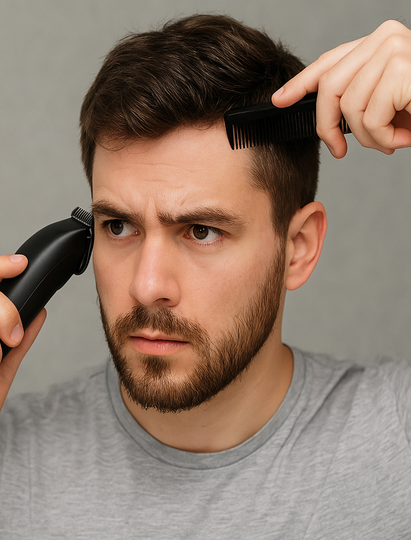Want a fresh cut without spending extra money at the barber? Learning to cut your own hair can save you time, money, and keep you looking sharp whenever you need it. Whether you’re going for a simple buzz cut or a stylish fade, this guide will walk you through everything you need to know to achieve a barber-quality cut at home.
What You’ll Need
Before you start, make sure you have the right tools:
- Clippers – A good pair of clippers with adjustable guard lengths and a strong motor.
- Scissors – For trimming longer hair on top.
- Hand Mirror – A 360-degree mirror setup makes it easier to see the back of your head.
- Comb – Helps section your hair and keep it even while cutting.
- Cape or Towel – To keep hair from getting all over you.
- Spray Bottle (for longer hair) – Helps control the hair while cutting.
Step-by-Step Guide to Cutting Your Own Hair
Step 1: Choose Your Style
Before grabbing the clippers, decide what kind of haircut you want:
- Buzz Cut – One-length all around, super easy to do.
- Fade – Shorter on the sides, blended into longer hair on top.
- Taper Cut – Like a fade, but the hair gradually shortens at the neckline.
- Scissor Trim – Best for longer hairstyles.
Step 2: Start with the Sides
- Use your clippers with a longer guard (like a #4 or #3) to start.
- Move the clippers upward from the bottom of your sideburns to about 1 inch above the ear.
- Use a shorter guard (#2 or #1) for the fade effect.
- Blend the sections by switching to a medium-length guard (#3) between the top and bottom layers.
Pro Tip: Pull your ear down slightly to get a clean cut around the edges.
Step 3: Cut the Top
- If you want short hair on top, use a longer clipper guard (#6-#8).
- For longer hair, use scissors instead. Hold small sections of hair between your fingers and trim bit by bit.
- Style accordingly using pomade or gel.
Step 4: Clean Up the Edges
- Use a zero-gap trimmer or the bare clipper blade to clean up your neckline and sideburns.
- Use a hand mirror to check the back of your head.
- Blend any uneven areas by lightly running the clippers over them again.
Pro Tips for a Perfect DIY Haircut
- Always cut less first – You can always go shorter later!
- Use slow, steady motions – Don’t rush, or you might end up with uneven patches.
- Wash your hair before cutting – Dirty hair makes cutting harder.
- Style after cutting – Use pomade, gel, or wax for a polished look.
Save Hundreds on Haircuts!
Cutting your own hair at home can save you $300-$600 a year. With the right tools and techniques, you’ll always have a fresh, sharp look without waiting in line at the barbershop.
Next Steps:
Follow us for more style and grooming recommendations!
Share this guide with a friend who wants to cut their own hair!
Check out our other grooming tips and haircut guides.
